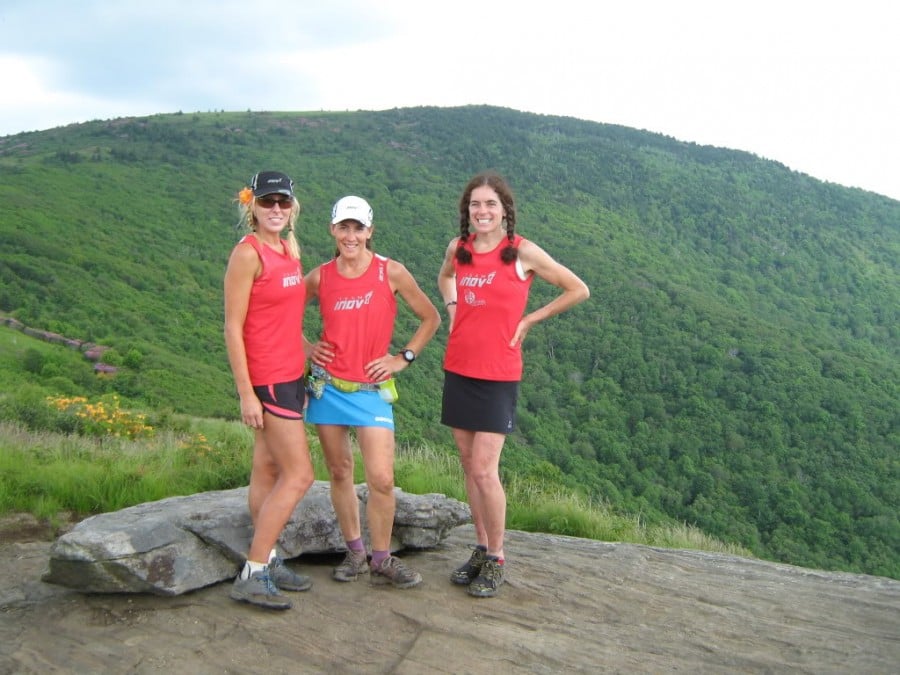Three women trek 260 miles across the 40 highest peaks in Southern Appalachia in a record-setting seven days.
Top trail runners Rebekah Trittipoe of Bedford, Va., Anne Lundblad of Asheville, N.C., and Jenny Anderson of Lynchburg, Va., journeyed to the 40 highest and wildest reaches of the Southern Appalachians to set a new speed record.
South Beyond 6000 (popularly known as SB6K) challenges hikers to reach the 40 southern Appalachian peaks exceeding 6,000 ft. in elevation. Only 170 people have completed the challenge in 40 years, and only one other person has conquered them all in one consecutive 260-mile trek.
Why were three of the country’s most accomplished ultrarunners considering such a wild adventure so different from their usual competitive undertakings? Trittipoe confessed she was anxious for a “women-only” adventure, and after contacting a few unsuspecting friends with her notion, “Anne and Jenny took the bait.” After considering several possibilities, Lundblad suggested SB6K.
“Competitions are fun and exciting, but I wasn’t really finding the sense of internal challenge and accomplishment that I was looking for,” said Lundblad. “We all liked the idea of combining long distance running with bagging peaks.”
The SB6K peaks are geographically distributed throughout the southeast’s highest ranges; these include the Great Smokies, Plott Balsams, Great Balsams, Blacks, Great Craggies, and Roans. Fourteen of the 40 peaks have no maintained trail to their summits. Crowned with nearly impenetrable spruce-fir forests and often guarded by a bloodthirsty maze of blackberry thickets and briars, these mountains are the giants of the southeast’s wildest country.
Lundblad admitted that she had little off-trail experience. “Before this run, my only off-trail adventures were when I’ve gotten lost on my trail runs,” she explained.
In 2003, Ted “Cave Dog” Keizer ran the SB6K peaks in just under 5 days, setting the overall speed record for the challenge. Supported by an extensive crew he dubbed “The Dog Team,” his route would be mirrored by the trio of women runners atop the region’s highest peaks. In his honor, they adopted feline-themed trail names: Mama Cat (Trittipoe), Dixie Cat (Lundblad), and Bohima Cat (Anderson). The Cat Women also used the upcoming quest to fundraise for Project Athena, an organization providing aid to women athletes who suffer catastrophic health setbacks.
After months of training, planning, and route finding, the Pride was ready to pounce in mid-June. They set off from 6,643-foot Clingmans Dome, the highest peak in the Smokies, just after 3 a.m. Following the Appalachian Trail, they reached their second peak, Mount Collins, well before the sun came up. Early starts and running in the dark would be a necessity every day to maintain their 40 mile-per-day pace.
By late afternoon on their first day, they reached the eastern Smokies range, one of the most wild and remote areas in the southeast. It is home to the most difficult peaks of the entire challenge, including Mount Guyot, the east’s highest trail-less peak, and Marks Knob, the farthest off-trail peak in the challenge. All of these summits are guarded by incredibly dense forests and steep slopes.
“In many ways, the thickness of rain forests are exactly like the type of growth and density we experienced,” explained Anderson, who has trekked in the jungles of Central America. “We climbed over blowdowns, crawled under branches, stomped through briars, and squeezed through closely grown balsam…hunting for the summits,” she added. “It was equally challenging finding our way back down to the trail.”
By the end of day one, they had summited nine peaks, finishing in crashing thunder and lightning. Electrical storms are among the most dangerous hazards when climbing the region’s highest peaks. But the danger didn’t end there. The Pride would receive a visitor at Tricorner Knob Shelter on their first night—a hungry 300-pound black bear that wandered into camp. Luckily, a ranger was present to scare it off, although the bear returned in the middle of the night, knocking into a cooking pot just a few feet from where the women slept. Again the bear was chased away, but no one slept well that night.
The next morning, they knocked off three more off-trail peaks in the Smokies, then exited the park to face an arduous 20 miles of road running. Through more heavy downpours, they pounded the Blue Ridge Parkway, and at long last, the skies parted on the trek to Yellow Face, their next 6,000-foot peak. At Yellow Face they soaked in the majesty of the surrounding mountains. The magical moment reinvigorated the Cats and served as inspiration to push onward.
The trio would need their newfound motivation to start their third day, setting out before sunup in another torrential downpour to traverse the Plotts. “We climbed Waterrock Knob with lightning crashing all around us,” said Anderson. “It was quite epic.”
Briars, blackberry bushes, and nettles obscured the faint paths to the Plott summits. “We surely got half of our war wounds from that trail,” continued Anderson. She later suffered several bee stings, and her body broke out in hives to accompany her cuts and bruises.
The Pride, barely escaping the Plotts in one piece, picked up the Mountains-To-Sea Trail and ascended into the Great Balsam Mountains, where they had to contend with Reinhart Knob, one of SB6K’s most notoriously difficult peaks. Though only a short distance from the Blue Ridge Parkway, the summit is well fortified. Its access is so hindered by colossal blackberry thickets that the preferred route involves ascending a perilous rock face through a steep and narrow chute.
In locating the correct rock chute, the ladies soon found themselves perilously clinging to the near-vertical mountainside. At its top, they were greeted with a wall of spruce and fir that even sunlight itself rarely penetrates. “We all paid the price in blood and scratches on that one,” said Trittipoe.
Day Four brought scenic relief to the battered Cats as their journey took them across the open balds of Shining Rock. Their morning jaunt to the summit of Black Balsam Knob, a grassy bald with a 360 degree view, was greeted with clear skies, breathtaking vistas, and even a breakfast surprise. Their friend Adam Hill greeted the ladies with a meal of eggs and chocolate chip pancakes.
Running the Art Loeb Trail over more scenic peaks like Tennent Mountain and Shining Rock treated the ladies to dramatic views throughout the day. “The open balds were spectacular,” said Trittipoe. The women unanimously named this section as their favorite of the journey.
It was also the first day that friends and crew members joined the team to run sections of trail. “We finally had a beautiful, sunny day with friends. We could see forever,” said Lundblad. “It was very special.”
The fifth day of the challenge took the runners across the Black Mountains, the highest and most brutal range in the eastern United States. From 6,684-foot Mount Mitchell, the highest mountain in the East, the route heads north to cross seven more peaks, each one with rugged, overgrown back-to-back ascents and descents. Many are so steep that ropes have been installed to rappel rock chutes.
“That section of trail will be embedded in my mind forever,” said Anderson. “It had relentless rocks, mud, technical terrain, and ropes.”
Another storm approached as they neared the northern end of the range. In dark skies and pouring rain, the sound of tornado sirens from the valley below reached their ears.
Before reaching their final range, the Cats had to tackle another laborious 20 mile road run to reach the Roan Highlands. With bodies worn weak and muscles turning to jelly, the winding asphalt proved demoralizing. “It was like a death march,” said Trittipoe. “I was so tired that my eyes continuously closed and I felt myself weaving all over the road.”
When they finally climbed Roan High Bluff, their first peak in their final range, a wrong turn resulted in a short bushwhack through thick rhododendron. They eventually emerged onto a paved trail leading to an overlook, startling several tourists. “We felt like lost zoo animals with the looks that we got,” said Anderson.
Meanwhile, their support crew assembled at Carvers Gap to run the final two miles with them. The Pride was crewed by their husbands—Mark Lundblad, Cory Anderson, and Gary Trittipoe—as well as Trittope’s son Seth, and friends Josh Yeoman and Robin Packer.
During the seven-day journey, crew members did everything from setting up campsites and cooking food to hiking ten miles with gear to a shelter, getting up at 3 a.m. to make oatmeal, doing laundry, and providing invaluable moral support and encouragement. “And they did it without receiving the glory and attention that we got,” said Lundblad.
As the Cats emerged from the forest, their arms and legs were ravaged with cuts, scratches, and bruises. Their strides were shortened by aching muscles. Yet they were all smiling. Hand in hand, they arrived at the top of Grassy Ridge Bald and kneeled together to kiss the final benchmark. They completed SB6K in 6 days, 13 hours and 31 minutes, a women’s record.
“I can’t imagine any better people to be with through this experience,” said Trittipoe. “We went as a team, and we conquered as a team.”
The team aspect set this challenge apart from many other long distance speed attempts. Several experienced long distance runners predicted they wouldn’t succeed because of the team element. But the women stuck together through some of the most harrowing physical and mental challenges.
“We were able to motivate and encourage each other to push through the low points,” added Lundblad. “We had a lot of laughs on the trail. I gained an incredible sense of connection with Rebekah and Jenny, knowing that this experience we shared is one we will never forget.”
The beauty of the mountains made the experience unlike any other. “Western North Carolina is one of the most beautiful and challenging parts of the entire country,” said Anderson.
“Sometimes we just wanted to bag a peak and leave—tired of being cold and wet,” admitted Trittipoe. “But other times, we desired to linger, hoping to capture the magic of the moment.”
And for Lundblad, the trek brought new perspective on her running career. “Through this experience, I discovered that while racing fed my ego, this adventure fed my soul.” •
Peter J. Barr is chairperson of the Carolina Mountain Club’s South Beyond 6,000 Challenge and has hiked all 40 summits. His second book, Hiking the Southeast’s Highest Peaks, will be released next summer.
ANNE LUNDBLAD
“Dixie Cat”
AGE: 42
HOMETOWN: Swannanoa, N.C.
DAY JOB: College Counselor
MOTHER: Emma, 9
RUNNING: 10-time National Champion, 2005 IAU World Cup 100K Silver Medalist, 6-time USA representative at IAU World Cup, Record Holder for JFK 50M, Mt. Mitchell Challenge, Promise Land 50K, Dupont Trail Marathon
FAVORITE PEAK: Black Balsam (Great Balsams)
MEMORABLE MOMENT: Known for “Doing a Dixie” for her many falls, including once while standing still.
REBEKAH TRITTIPOE
“Mama Cat”
AGE: 52
HOMETOWN: Bedford, Va.
DAY JOB: Medical Education Author; Online High School Teacher
MOTHER: Caleb, 21; Seth, 18
RUNNING: Past winner of Mountain Masochist 50M, JFK 50M, Rattlesnake 50K, 250K Brazil Jungle Marathon, Allegheny Trail Women’s Speed Record
FAVORITE PEAK: Mt. Guyot (Smokies)
MEMORABLE QUOTE: “I felt like Dora the Explorer.”
JENNY ANDERSON
“Bohima Lion”
AGE: 35
HOMETOWN: Lynchburg, Va.
DAY JOB: High School Spanish Teacher
MOTHER: Logan, 9; Jordan, 7; Ryleigh, 3
RUNNING: Past winner of Terrapin Mountain 50K, Rattlesnake 50K, Forget the PR Mohican 50K
FAVORITE PEAK: Yellow Face (Plotts)
MEMORABLE QUOTE: “At least we don’t have chiggers.”








